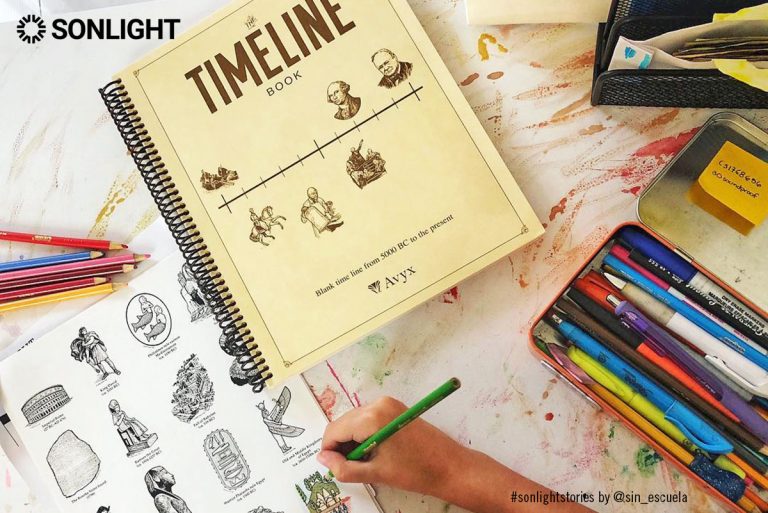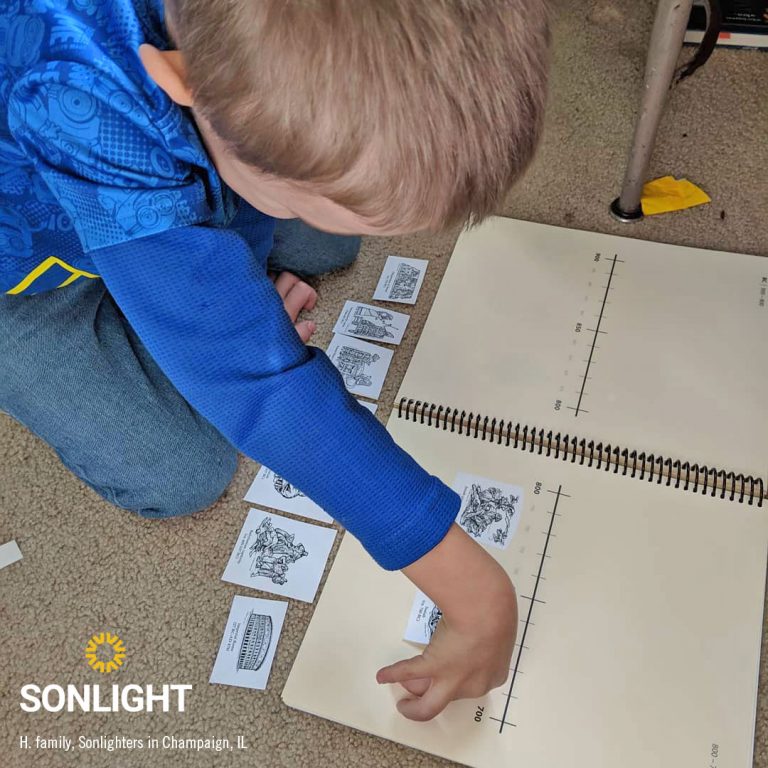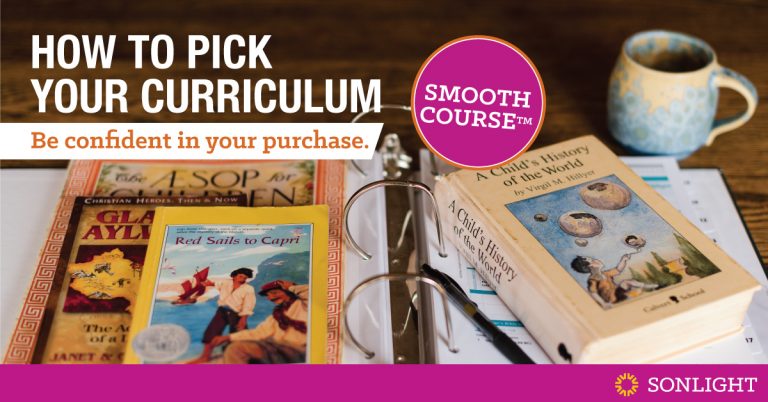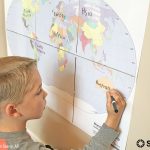
Although Sonlight’s complete curriculum makes choosing a program for your child easy, The Timeline Book is can seem rather vague to new homeschoolers. They may have a hard time visualizing how it works or what benefits it brings.
Once I started using The Timeline Book and Timeline Figures regularly, I began to see their purpose. Then I came up with several methods to make timeline figures a meaningful part of our homeschool routine. To our surprise, timeline figures have become a fun, fast, and simple way to boost learning, just as Sonlight always intended.
What Are Timeline Figures?
Timeline Figures are black and white drawings of famous people and events printed on paper with a removable backing to reveal a sticker layer underneath, so they can easily be placed into The Timeline Book after cutting them apart. They can be colored in if you choose to make them appear brighter and more fun. The Timeline Figures are selected and identified in your Instructor’s Guide from the books you read throughout the year in your History / Bible / Literature (HBL) program.
Sonlight sells timeline figures for every level from HBL A through HBL J. These are included if you order a full grade package, or a complete HBL package.
One copy of The Timeline Book will take you through all levels. Our family likes to have one copy of The Timeline Book per child; others enjoy having one book per group of children doing the same level, or one book per family. In HBL 100 and up, timeline figures are suggested, but not provided.
Sonlight also include suggestions for other Timeline Figures from other levels. Not all historical figures that are discussed are placed in every year, so each year you are ensured a new batch of timeline figures to affix. These will be indicated by a different symbol in your Instructor’s Guide. You will notice those figures do not have stickers included. The timeline stickers for those figures can usually be found in a different HBL and will be added in another year. If you don’t want to wait that long, you can always write them in.
Why Use Timeline Figures?
Timeline Figures help my children sense how much time is passing. Younger children often have a hard time visualizing how far away ago the year 1612 was. They many not have realized Catherine the Great from Russia and George Washington lived during the same time period. Over the years, as you add more Timeline Figures, you can see your children actually forming connections between people they’ve read about in past years and people they’re currently studying.
Each time they look through The Timeline Book to find where a new figure goes, they create a new visual memory of people and events they’ve already discovered. This helps keep those names and events fresh in their memory banks instead of forgotten by the wayside.
Added Benefits of Homeschool Timelines
Not only do the Timeline Figures create reminders of what you are learning, but they also juxtapose a variety of learning styles and techniques, helping transfer short-term references into long-term knowledge.
- Visual: They observe what is happening in illustrations in the books. They can follow the lives of important people and visualize how certain events and other famous figures may have influenced their lives.
- Auditory: Your child hears what you are reading to them. They listen to stories about people, places, and events, and how they all tie in together. Then, they match the figure to the story.
- Interpersonal: You and your child discuss the story. Your child may confer with you over which timeline figures to use and where to place them, and review about what else is happening in the world, where events took place and who was there.
- Kinesthetic: Placing timeline figures helps learn events through movement and touch. Positioning timeline figures in The Timeline Book and paging through to find the right spot provides further stimulation.
- Reading and Spelling: As children read the names and events on the timeline figures, they are further familiarizing themselves with often unique or hard-to-spell names and places. They are seeing how the words are spelled and used together to form titles such as King Henry VIII, Sir Galahad, and Martin Luther King, Jr.
Tips for Using and Remembering the Timeline Figures
Sometimes, when life is busy, it gets hard to remember to use the Timeline Figures. Sometimes I intend to use them but forget or get behind. Here are ideas to help:
- Daily Enhancement: Look at the Instructor’s Guide ahead of time, and note where Timeline Figures are mentioned. Little symbols have been placed there to aid you. If you find these don’t stand out enough, consider highlighting them or using colored sticky flags to help them stand out on the page. This will make it harder for you to skip or forget them. Keep The Timeline Book and Timeline Figures in easy reach with your other books. You might consider getting a pocketed page divider or hole-punching the Timeline Figures so you can easily store them in your Instructor’s Guide, making them more convenient and less likely to interrupt your flow.
- Regularly Scheduled Review: At the beginning of each year (or semester, week, or any given period of time), cut out the Timeline Figures you will need and identify where they go. Put them in a plastic baggie, or paperclip them to the top of the page. If you use a plastic baggie, poke a small hole in it, so it easily slips onto the loops of your binder, holding it in place on the week they will be used.
- Sporadic Review: On the back of the figures, jot down which book and which week the Timeline Figures are mentioned in. Whenever you like throughout the year, or at the end of the year for a review, pull them out and place them in. See how much your children can remember. If you have trouble remembering where they were mentioned, you can refer to the back of the figure to help you find its place in the Instructor’s Guide.
Activities and Games to Help Timeline Figures Come Alive
- Play a Map-Matching Game: Before placing the Timeline Figures in The Timeline Book, first place them on a map in the country of their birth, the country they had the most influence in, or move them around as you read to follow their travels. When you are finished discussing them, stick them into The Timeline Book.
- Create a Timeline Game: Cut off or fold under the dates of the Timeline Figures and have your child try to see if they can place all the Timeline Figures in the correct order. Have them try again to see if they can beat their time. They can also tape or paste them together into a long line to create a different type of timeline.
- Make it Meaningful: Keep the activities fresh by adding events and people that are meaningful to your family. Add pictures of relatives and ancestors to The Timeline Book on their birthdays to help show where they fit into history. Draw lines to keep time periods together. Add in current events that are meaningful and little-known historic events you discover along the way.
- Keep it Visible: The Timeline Book can sit in a prominent area to increase visibility. Hang a simple strip of adding machine paper on the wall for a visible timeline. A wall timeline, however, is prone to fingerprints, and can be hard to move with you. Thus I prefer Sonlight’s notebook style timeline instead. But just seeing The Timeline Book can help make it easier to remember to do it and provide those extra benefits.
Timeline Figures are such a small part of your homeschool history curriculum, they might seem insignificant in light of all the other things your children are learning. However, these figures can bring together many key points and ideas and are a great way to provide more references for historical figures and dates without having to memorize. These simple figures provide a huge value!
Let us walk you through your curriculum selection process. It's easy!









